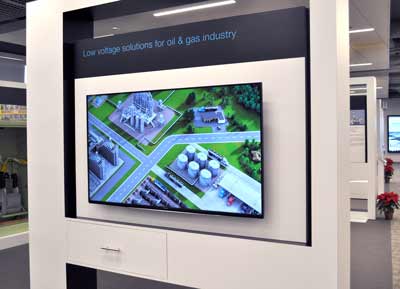1. Commercial displays are built with durable, reliable enclosures – In this case, an enclosure refers to the bezel that surrounds the screen and a casing that covers the back. Commercial enclosures have been designed, redesigned and redesigned again to facilitate an optimal fit in various commercial settings. For example, commercial displays designed for restaurants are built to withstand more intense heat and can repel grease. In exterior applications, the enclosure is fortified against dust and moisture.
Consumer televisions are only built for the home environment. They aren’t going to handle any other setting well, which means they will fail sooner.
2. Commercial displays offer true 24/7 reliability – Even if the display is going to be used in a cool, dry environment, with no hazards to speak of, merely utilizing a television 24/7 is going to burn it out quickly. The first thing most people notice when picking up a commercial display is that they are considerably heavier than consumer televisions. This is because they are built with heavy duty components like additional fans and enlarged heat sinks. These are essential in mitigating the additional heat that comes with continuous operation. And heat will bring down a display faster than just about anything else.
3. Commercial displays are built with additional connectivity options – Televisions don’t have to accommodate many external devices. Perhaps a DVD player or media streamer and that’s about it. For this reason, they are built with basic connectivity. A commercial display, though, has to be networked, set up for proper communication and attached to one or more media players. This takes additional inputs and ports, and if using a consumer television, there is always the chance that it won’t be compatible with a particular signage technology.
4. Commercial displays offer better brightness options – A consumer television is usually set close to 250 nits in brightness. That is enough for the home, but under commercial lighting, that level of brightness won’t be enough, and images will appear washed out. It’s even worse if the display is brought outside, and there’s no chance that a consumer television will produce a bright enough image for outdoor use.
Commercial displays are capable of much greater brightness levels. The standard range is between 700 nits and 3,000 nits. The former is plenty for areas with commercial lighting, while the latter can produce a clear, crisp image even under sunlight.
5. Commercial displays are built with burn-in protection – If a consumer television is forced to display a single image or series of images around the clock for days on end, it will start developing artifacts due to the strain. This is known as image burn, and it’s often what ruins a television’s ability to provide signage. Manufacturers will not provide burn-in protection for consumer televisions, for obvious reasons.
But commercial displays are built with this protection, which means they can be operated 24/7/365 without developing any visual artifacts or ghost images.
6. Commercial displays come with better warranties – Manufacturer warranties have to take into account what the display is going to be used for. A consumer television is not intended for use as digital signage, and the warranty that comes with a television reflects this. If the owner goes ahead and uses their television for digital signage anyway, they will receive an unwelcome surprise when it inevitably comes time to service or replace the television. Most manufacturers will either reduce the warranty’s available period greatly or will void it outright.
Commercial displays are packaged with warranties that reflect the display’s quality. Instead of a month or two of protection, commercial displays are often protected for years following installation.
7. Commercial displays can be controlled with greater ease – Because digital signage is usually controlled remotely, commercial displays come with additional features to facilitate remote display management. For example, commercial displays can be configured so that their sleep mode never engages. This forces the display to stay on until it is powered off. And powering on/off can be done on a schedule, so businesses can program exactly when a display should be on, and when it should be off.
Consumer televisions don’t have features like these. They have to be powered on and off by someone in person. They can’t be programmed to switch on and off remotely, so if someone forgets to switch them on, that means no signage.
8. Commercial displays come with additional orientation options – Consumer televisions are only designed to be oriented in one way – horizontal. And that may be the orientation a business selects for their signage. However, if a business wants its signage to stand out a bit more, commercial displays can be arranged vertically. This can also help if space constraints are present, which is often the case in restaurants where customers order at the front.
Further, commercial displays can be tied together to create impressive video walls. A video wall is extremely powerful in getting attention, but it’s something that just can’t be done with consumer televisions.
When considering whether a 24/7 display is needed and which option to choose, it’s best to think of consumer televisions and commercial displays as two entirely different technologies. They may look the same and appear to do the same thing, but put them side by side in a 24/7 signage setting, and it will soon be clear why commercial displays are the better value in the long run, and really the only option that makes sense in a business environment.


